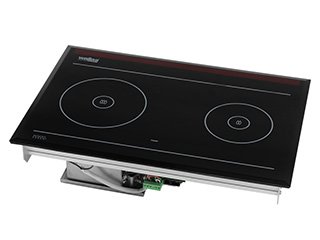This post has already been read 3085 times!
Roy Tipping gives his experience:
Our first Morello was gas-free. In general we were very pleased with it. The main advantage in the older model was that you gained extra storage where the Gaslow bottles used to be stored. That no longer applies to the modern design with the underslung tank. The compressor fridge could be left running on ferries which was very handy on the ferry to Spain (and on Eurotunnel). Those with absorption (gas powered) fridges which had to be turned off on the longer ferries had to fill up with freezer bags and hope for the best. It was also an advantage in those countries, such as Morocco, without LPG pumps, though the 20 litre gas bottle on the latest models shouldn’t need filling very often.
The disadvantage of the diesel powered hob was that it was, in effect, a single burner hob with two areas of heat, one hotter than the other. You could fry on one area while you were boiling on the other, or you could boil on one area while you were simmering on the other. It would be tricky to fry and simmer at the same time, and pretty difficult to manage three pans. It was also slow to adjust, either for extra heat or to reduce the heat – gas is much better in this respect. We found that you spent a lot of time moving the pans around to find the correct temperature. That being said, we never found it difficult to cook on it. We noted no impact on diesel consumption with the diesel hob – it was very economical. There was a very definite whiff of burnt kerosene downwind of the Morello when cooking – it smells a bit like the old paraffin Primus stoves from scouting days.
We had both break down once in our five years with the Morello. The hob needed the igniter to be replaced – the fitter said that you get plenty of warning when the time is coming up since the hob starts to make a curious noise ‘like a strangled trumpeter’. Regular servicing wasn’t needed and replacing the igniter was neither a long job nor expensive.
The control board on the absorption fridge failed and I carried out a Heath Robinson modification while waiting (a long time!) for the Waeco part to arrive. Murvi took the Morello in part exchange, with the faulty refrigerator and spare part needing marrying up, and they couldn’t manage it, so fitted a new fridge for the next owners. I was not impressed with either the Waeco fitter or with the spare part service. Waeco are now part of Dometic and I got the impression that Waeco equipment didn’t get the same quality of treatment or training as Dometic’s own stuff.
In our present van, which we bought from new, we chose a mains/gas/12v refrigerator and a gas hob. We could have had a compressor fridge, with which we would certainly have been happy (apart from worries about servicing), and a diesel hob, with which we would have been much less happy. I think the fact that we changed to a much more conventional set-up is an indication of where our preference lies.
Worked fine – leave on while travelling (at full power unlike a gas fridge
which has to rely on 12v to maintain whatever temperature it is when turned
to 12v – unless very warm when it looses the battle). Worked without a
problem and no servicing required.BUT it depends on where and what style of travelling you do. The fridge
takes a real hunk out of your battery power so if you want to stay away from
mains then GO GAS. My estimate was that with the (then) gas fired heating in
Autumn I would be lucky to last 3 days off mains. In winter it is a
balancing act between cold weather (fridge needs less juice) and warmth
(Morello heaters need battery power as well – and at least a reasonable
amount of it – more for older models at least to get started). If you mainly
rely on mains hook ups and a solar panel then a compressor fridge is a
really good option if it helps you be more independent from gas. But as Roy
& Kath said, an under-slung gas tank lasts a long time.
and John Laidler‘s thoughts:
Compressor refrigerators are best for high ambient temperatures although you can get fans for the absorption refrigerators which help them work more effectively when it is hot. But as mentioned compressor refrigerators take more power which could be a consideration if wild camping.
We didn’t have a problem turning our ‘fridge off for the Santander ferry, just made sure the ice cube tray was empty.
I think diesel cooking would only be a benefit if you were going places where lpg was unavailable.
And back to Andy Embling:
I suggest that Roy’s figures are a little optimistic. We flattened our battery in the Hebrides – the main culprit being the fridge. The attached link gives an idea of the normal power consumption of Waeco compressor fridges which shows at the lowest around 5 amps (presumably maximum) which as Roy says in summer will be high (most of a solar panel) but less (but in our experience still significant) in winter (perhaps because we like to stay pretty warm in the van). Our experience is dated, but these figures from Waeco are current).
